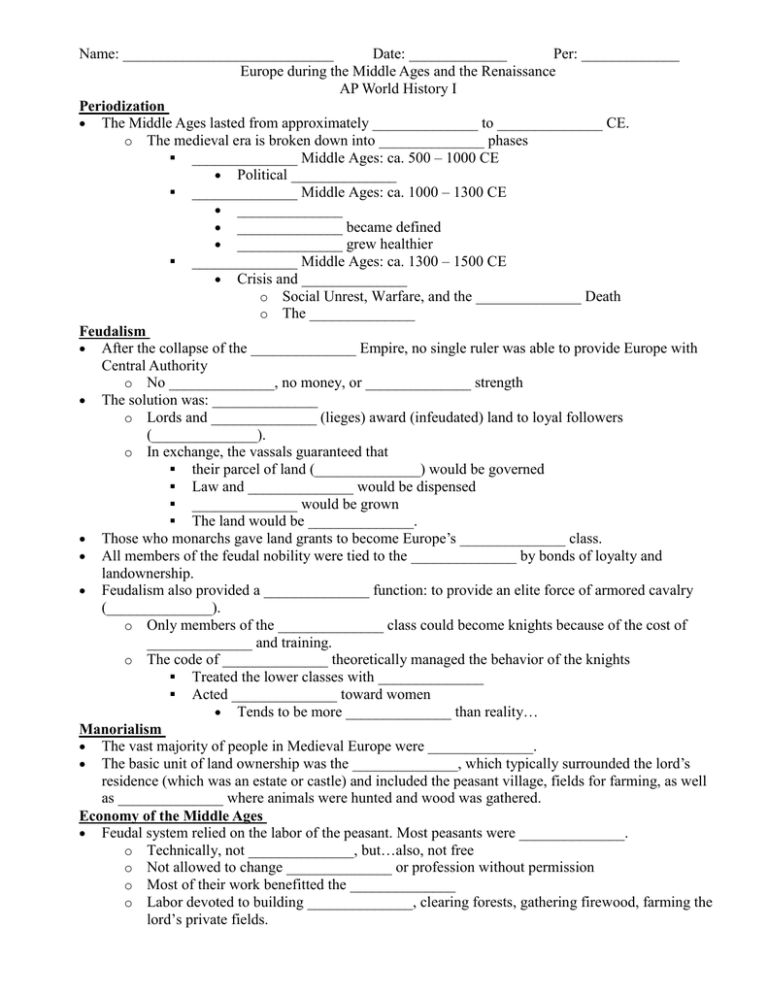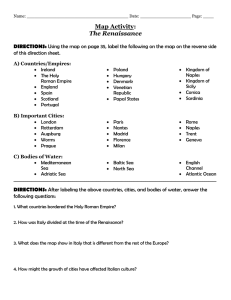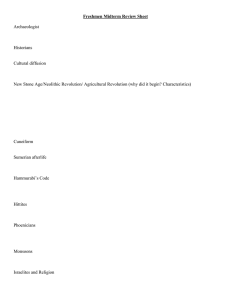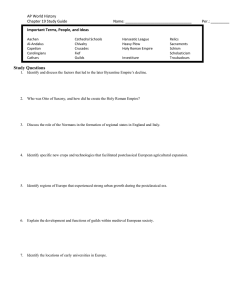Name: ____________________________ Date: _____________ Per: _____________
advertisement

Name: ____________________________ Date: _____________ Per: _____________ Europe during the Middle Ages and the Renaissance AP World History I Periodization The Middle Ages lasted from approximately ______________ to ______________ CE. o The medieval era is broken down into ______________ phases ______________ Middle Ages: ca. 500 – 1000 CE Political ______________ ______________ Middle Ages: ca. 1000 – 1300 CE ______________ ______________ became defined ______________ grew healthier ______________ Middle Ages: ca. 1300 – 1500 CE Crisis and ______________ o Social Unrest, Warfare, and the ______________ Death o The ______________ Feudalism After the collapse of the ______________ Empire, no single ruler was able to provide Europe with Central Authority o No ______________, no money, or ______________ strength The solution was: ______________ o Lords and ______________ (lieges) award (infeudated) land to loyal followers (______________). o In exchange, the vassals guaranteed that their parcel of land (______________) would be governed Law and ______________ would be dispensed ______________ would be grown The land would be ______________. Those who monarchs gave land grants to become Europe’s ______________ class. All members of the feudal nobility were tied to the ______________ by bonds of loyalty and landownership. Feudalism also provided a ______________ function: to provide an elite force of armored cavalry (______________). o Only members of the ______________ class could become knights because of the cost of ______________ and training. o The code of ______________ theoretically managed the behavior of the knights Treated the lower classes with ______________ Acted ______________ toward women Tends to be more ______________ than reality… Manorialism The vast majority of people in Medieval Europe were ______________. The basic unit of land ownership was the ______________, which typically surrounded the lord’s residence (which was an estate or castle) and included the peasant village, fields for farming, as well as ______________ where animals were hunted and wood was gathered. Economy of the Middle Ages Feudal system relied on the labor of the peasant. Most peasants were ______________. o Technically, not ______________, but…also, not free o Not allowed to change ______________ or profession without permission o Most of their work benefitted the ______________ o Labor devoted to building ______________, clearing forests, gathering firewood, farming the lord’s private fields. Had to pay fees to use the manor’s ______________, including the bread oven, water mill, and cider press. o In times of ______________, serfs had to fight. Christianity Christianity acted as a ______________ force for European nations following the fall of Rome. o ______________ and ______________ unification… 1054: Great ______________ o Doctrinal differences between the Roman Catholic and ______________ Orthodox church (centered in ______________) led to a permanent split. Monasteries preserve ______________ and Greek manuscripts from the Roman Era o ______________ and philosophical essays, literary works, etc. Leader of the Catholic Church was the ______________ o ______________ and Cardinals act as advisors o Bishops o Priests o Monks and ______________ After 1000 CE, the church became increasingly powerful. o In contrast to the Eastern ______________ Church, which viewed itself as subservient to ______________ authority What did the Pope do? o Many popes (especially Innocent III 1198 – 1216) went to great lengths to assert the authority of the ______________ as superior to that of ______________ and emperors. o Moral authority to determine what was ______________ o Had the right to ______________ worshippers from the Catholic Church o Had the right to issue calls for holy wars (______________). o Goal was to join all of Europe into a Single, ______________ Community. The attempt as this is known as ______________. Catholic Church owned vast amounts of land o Right to collect ______________ (taxes) The Church exercised power by controlling ______________, thought, and culture. o 1231: The Holy ______________ was a set of courts with wide-ranging powers set up to hunt out and punish heresy and religious ______________. ______________: formation of religious communities whose members (______________ and nuns) are not ordained by priests. o ______________ model was most influential from 500s – 1100s and stressed contemplation and seclusion o After the 1100s, the ______________ and ______________ carry the works of the church to the wider world. Early Kingdoms Weak states, decentralized governments dominate the 500’s and 600’s o ______________ raids and Muslim invasions The ______________ Kingdom (Carolingian Empire by the 700s) o The Franks were a ______________ tribe o Under King ______________ (465-511) who acquired parts of Germany, France, etc. Converted his people to ______________ Under Charles ______________ the Frankish Kingdom grew strong again (688-741) o Successfully turned the Muslims back at the battle of ______________ (732 CE) o His son, ______________, strengthened ties with the Catholic church Pepin’s son, ______________ (768-814) was even more successful. o Defended ______________ territory against Viking, ______________, and Muslims. o Expanded the kingdom and transformed it into the ______________ Empire o o o o o Pope crowned him Holy Roman Emperor in ______________. Supporter or ______________ (church-based) Strong, but still ______________. In ______________, Charlemagne’s three grandsons divided the territory into smaller parts The concept of the Holy Roman Empire ______________ though… A ______________ allied with the ______________, yet able to provide ______________ authority… Early Nations… 800s and 900s o ______________ Kings unite large parts of England o ______________ Dynasty comes to rule the area around Paris and gradually all of ______________ o Eastern, ______________ portion of Charlemagne’s empire reformed itself as the Holy Roman Empire Will rule most of ______________ Europe for years… The Vikings Expert Sailors, fierce ______________ From ______________ ______________ causes exploration, migration throughout the 800s to the 1100s. o Raided and ______________ land throughout Europe o Colonized ______________ and ______________ o Leif ______________ lands in Canada around 1000 CE. o Settle in parts of ______________, Scotland, and Ireland. o Establish kingdoms in ______________ and Sicily o Establish trade route from Scandinavia to ______________, through Russia, creating the first Russian “state” England and France In 1066, ______________ the Conqueror leads the ______________ Conquest of England. o Normans were descendents of ______________ who had settled in France. o William defeated the ______________ King in England. o The rule of England and France was thus ______________ through blood ties from 1066 to around 1400. Norman Conquest brought ______________ -style Feudalism to England o Cultural ______________ with ______________ and ______________ -Saxon groups. England became more centralized, even as significant ______________ were placed on the monarch. o 1100’s: ______________ Law (single law code) and Jury based trials o 1215: ______________ ______________ -Guaranteed rights to English nobility in limiting the power of King John. o Later 1200’s: Nobility wins the right to form a ______________ Will become a ______________ law-making body that governs in conjunction with the monarch o 1200s and 1300s: English monarchs extend rule to ______________, Scotland and Ireland In France, ______________ kings centralize their nation by increasing their own power. o They only ruled a tiny part of ______________ at first… England controlled ______________ and Brittany Flanders and ______________ were independent. Capetian monarchs will expand the size and scope of the French ______________ by gaining control over independent regions and beating the ______________ in a number of wars. o By the mid-______________, France was ______________ and centralized o French kings were of the ______________ ______________ in Europe French monarchs were not limited or ______________ to ______________ power 100 Years War (1337-______________) o England vs. ______________ o England was the early victor, gaining control over more than ½ of France. o After the 1420’s, with the help of warrior maid, ______________ of Arc, the French King was able to drive out the ______________. o This ended many of the ______________ connections between the English and French royal families. Central and Southern Europe Holy Roman Empire dominated most of ______________ Europe o Multi-cultural monarchy in which the crown passed back and forth amongst a group of ______________ noble families. o Founded in the 900’s by the heirs of ______________ o The Emperor was supposed to work in partnership with the ______________, but in reality they ______________ more than cooperated. The Holy Roman Empire was one of Medieval Europe's largest states, but the Emperor’s powers were comparatively ______________. o Position was not hereditary…chosen by the empire’s most powerful ______________ families The Holy Roman Empire was ______________ diverse o ______________, Italian, ______________, Slavic, and more!) Almost 200 duchies, kingdoms, and ______________ in the mid-1300s!! Central and Southern Europe-movement towards centralization Charles IV issues the ______________ ______________ (golden seal…Latin bulla) of 1356. o Asserted the rights and powers of ______________ under the emperor o Attempted to ______________ rule from the Pope o Reduced the number of ______________ allowed to elect the emperor (from all to seven) The ______________ family of Austria emerge as major players in imperial politics during the late 1200s. o By 1438, the Habsburgs will have power over the Imperial throne, not losing it until 1918. Central and Southern Europe Italy: Part of ______________ Italy was under the control of the Holy Roman Empire. Areas in the south passed in and out of ______________ control (French, Spanish, Muslim, Byzantine). The parts of Italy that remained free were governed by dozens of city-states. Italy was highly ______________, highly cultured, and had a strong commercial economy. o ______________, Milan, and Venice in the North, and Naples in the South. o Venice created this era’s richest and most powerful ______________ and commercial empires. Spain and Portugal Medieval development of Spain and Portugal was shaped by the fact that they were taken over by ______________ in the 700s (known as ______________). From 1031 onward, the people of Spain and Portugal fought the Moors in what was known as the ______________. o By the 1200s, the Spanish had pushed the moors into ______________, the southernmost part of the country. o The Moors held out in Granada for the next 200 years until they were expelled by ______________ and Isabella in 1492. Effects of the Moorish occupation: o Spanish territory was liberated ______________ by region, thereby leaving newly freed areas as independent, delaying ______________. o By the 1400’s there were about 6 Spanish ______________ o Only in the late 1400’s when the leaders of the two largest Spanish kingdoms, Ferdinand of ______________ and Isabella of ______________, married and joined their lands together did Spain take shape as a single country. o ______________ authorities became rigid in terms of ______________ o Muslims and ______________ were ______________. Benefits: Islamic culture was more ______________ than that in Medieval ______________ o Spain had access to ______________, scientific, and ______________ knowledge. o Spanish city of ______________ was one of Europe’s greatest centers of learning and science. o This will have a direct result on Portugal’s move towards world ______________ beginning in the mid-1400s. Eastern Europe and Byzantium Byzantine Empire becomes the ______________ between Christian Europe and the ______________ Middle East. The Byzantine Empire also joined the ______________ East with ______________, India, and the East Indies via ______________ trade routes. While the Byzantine Empire directly inherited the ______________ of the Roman Empire, it had entered a long period of ______________. th 11 Century: The Seljuk Turks become a formidable enemy. o Battle of ______________ (1071) and onward continually strip territory away from the ______________ Empire. Followed by the conquests of the ______________ Turks ______________: Ottoman Seizure of ______________, destruction of the Byzantine Empire, Constantinople becomes ______________ Eastern Europe tended to be poorly defined, ______________. o Invasions from the East…______________, Ottomans, etc. Hungary, Sweden, and Poland were exceptions o ______________ and sophisticated. Russia was a loose confederation of city-states, governed by feuding ______________. o ______________ invasions bring the rule of the ______________ Horde in the 1240s o Freedom in the 1400s under the leadership of the tsars of ______________ (Muscovite Princes) The Crusades Reasons for: o Convert ______________ o Crush Christian movements the ______________ considered to be ______________ o Resist attack by foreigners that were not ______________. First Crusade (1096-______________): Byzantine Emperor asked Christian Europe for military assistance against the ______________ Turks, who had captured ______________. o Pope Urban II summons the Council of ______________ and calls upon the knights of Western Europe to retake Jerusalem and the Holy Land from the ______________. o First crusade was a success for the Christian knights by ______________ in one of the bloodiest examples in military history, butchering every Muslim and Jew within the city walls. o Lack of unity amongst the ______________, Arabs, and Muslims contributed to their ______________. After the First Crusade, the Europeans set up four ______________ Kingdoms, which served as a ______________ and political ground-zero in the middle-east. o It also allowed Christians to get involved in the lucrative ______________ and commercial ______________ already existent. Christians remained for two centuries, but Muslims organized to drive them out on numerous occasions. o ______________ fell back to the Muslims in 1187. o Crusades lost focus in the ______________ Crusaders sack Christian ______________ in 1204. o In 1291 the Christians abandoned their last major outpost in the Middle East, ___________. Effects of the Crusades Deteriorating relationship between Christian/______________ worlds. Greater awareness of the ______________ -world Knowledge of, and desire for the economic wealth to be gained by greater ______________ with the ______________. Fighting for a cause…leads to the development of powerful myths of ______________, chivalry, etc. Fighting for a common cause united a ______________ Europe. Urbanization From 1000 to 1300 population ______________ in Europe was considerable. o Advanced ______________ techniques ______________ -field system of crop rotation Invention of better ______________ o Food supply ______________ Trade and ______________ become a part of European economy. Political stability encourages o ______________ o Movement of ______________ (on water) o ______________ routes Trade routes sprang up in Italy, on the ______________ River, in the North Sea and English Channel, and throughout the ______________ Sea o ______________ League: Group of traders whose influence stretched from England in the west to Russia in the East. Banking made trade more feasible and ______________. The majority of people remained on the countryside as peasants and ______________. But, there was an increasingly large number of people moving to ______________. o Great sources of ______________ o Attracted artists, ______________, and scholars. o Urban populations included shopkeepers, ______________, tradespeople, and laborers Growth of cities encouraged ______________ of labor. o Skilled trades were organized in the ______________ System, which were labor groups that maintained a ______________ on their trade. Restricted ______________, established prices, and set standards of quality and fair practice. City life was often ______________, polluted, and many people lived in ______________. Cultural opportunities and the opportunity to gain greater ______________ were benefits to city life. “City air makes you free” o If a person left the ______________ and went to the city for a year and a day, they were released from their status as a ______________. Social Stress Increasing urbanization was coupled with tremendous social ______________ o Uprisings and ______________ by peasants Causes: o ______________ of the climate (little ice age) affected harvests o More and longer ______________ were being fought Armies grew ______________ Increased cost of new technology like ______________ More peasants were forced into ______________ service o Taxes ______________ Social Stress Persecution of ______________ Black Death (______________ plague) o After killing millions of people in ______________, the disease traveled westward to the Middle East, then onto the shores of ______________ in 1347. 1347-1348: ______________ Europe 1349-1350: Central Europe and the British ______________ 1351-1353: Russia and ______________ o The initial bout of the plague killed 25-30 million people, roughly ____of the population of Europe. Women in Medieval Europe Women were subservient to men in Europe. Rights were determined by ______________ status. Lower Status: Cared for the household and assisted with ______________, bore children and raised them, work as servants for ______________ class families. o Of the few peasant women to leave a mark was ______________ of Arc (1410-1431) Women had some ______________ rights o Could own and ______________ land and property. o Women could separate from husbands, but divorces and ______________ were difficult. o Women had ______________ protection, but often not equal. Women in Medieval Society Aristocratic women could exert much ______________ and ______________ influence. o If a women was heir to valuable property or a ______________, she was a desirable match. o ______________ often served as ______________ for young kings whose fathers had died early, until their sons came of age. Some women ruled in their own right…as ______________ (not customary), o Countries where their legal system was based on ______________ tribal law (______________), such as France and the Holy Roman Empire did not allow women to inherit the throne o Women could rule in ______________, parts of Spain, ______________, and other places. Example: ______________ of Aquitane who married Louis VII of France, then Henry II of England. Medieval Culture Dark Ages? o Not so during the High and Late Middle Ages, but even so…Medieval Europe lagged behind ______________ and Islamic Middle East Most important factor influencing culture was the ______________ Church o Administered institutions of ______________ (Monasteries, then universities) o Largest employer of artists, ______________, and musicians. o Art and ideas that were not in line with Church doctrine could be banned. Another factor influencing Medieval culture was classical ______________ that was preserved from Ancient Rome and ______________. o ______________ was Europe’s language of ______________ and culture. o Knowledge of Greek learning came later through ______________ and Arab translations Aristotle’s writing on ______________, philosophy, ethics, and politics were adapted by Christian scholars. Sometimes, Greek science encouraged mistaken ideas in their application to Christianity, such as the ______________ model of the universe, which argues that the sun revolve around the earth. Medieval Art was ______________ in nature o ______________, or religious paintings, were inspired by Byzantine styles, even in Catholic Europe. Medieval music was ______________, known as ______________ chant…human voice, unaccompanied by instruments. o Over time, arrangements become more ______________, including instruments The greatest achievement of ______________ architecture was the ______________, which required skill, money, and decades to build. The ______________ o ______________: thick walls, small windows, square build o ______________: tall, slender spires, large stained glass windows, ornate carvings, flying buttresses. Medieval Europeans were great Castle-Builders… o th th ______________ and Minstrels popularized nonreligious music in the 11 and 12 centuries. Dante Alighieri, Geoffrey ______________ encourage the use of the ______________, or native language. o Latin remains the language of the ______________ elite, but it became more acceptable to write in the ______________ for serious poetic and literary works. Stimulated growth in ______________. Principal philosophy during the Middle Ages was ______________ o Attempted to reconcile ______________ (logic, the sense, and the learning of the ancient Greeks and Romans like Aristotle) with faith in God and ______________. o Thomas ______________ (1225-1274) was foremost in this field of ______________. Between 1436 and 1437, Johannes ______________ (German) developed the concept of the Printing Press. o Originated in ______________, possibly Korea. o ______________ printing was expensive…Gutenberg created a ______________ -type printing press in which individual, ______________, metal characters could be placed in a frame to form text. Raised ______________ rates Spread ______________ Increased the impact of new ideas and ______________ theories Encouraged the expansion of libraries and ______________. Indispensable role in the ______________, Protestant ______________, etc. Notre Dame Cathedral




